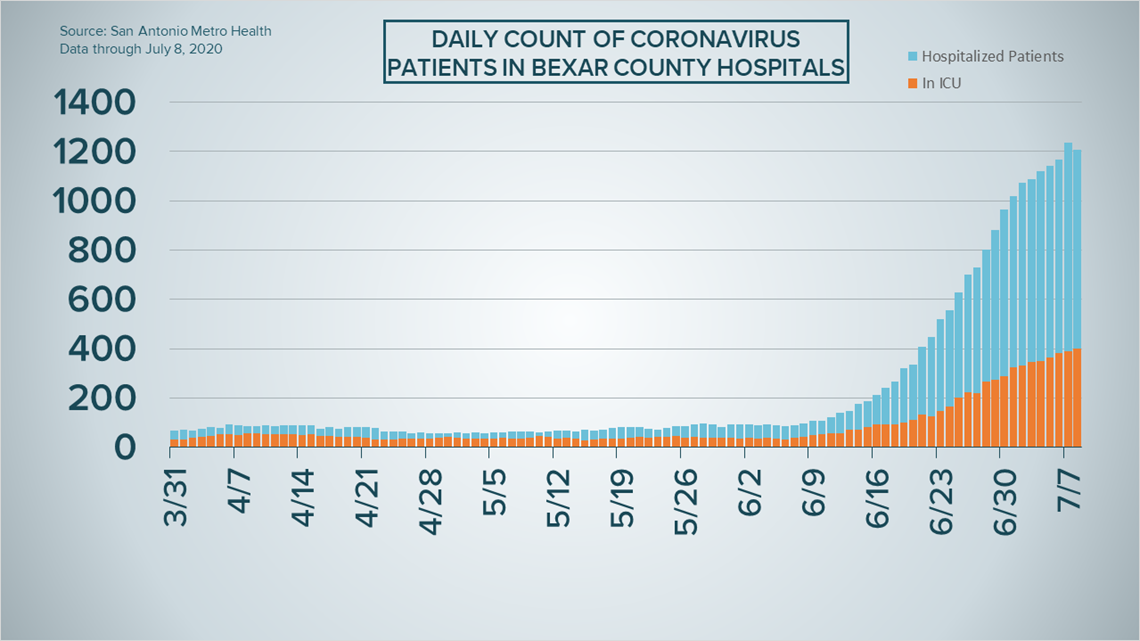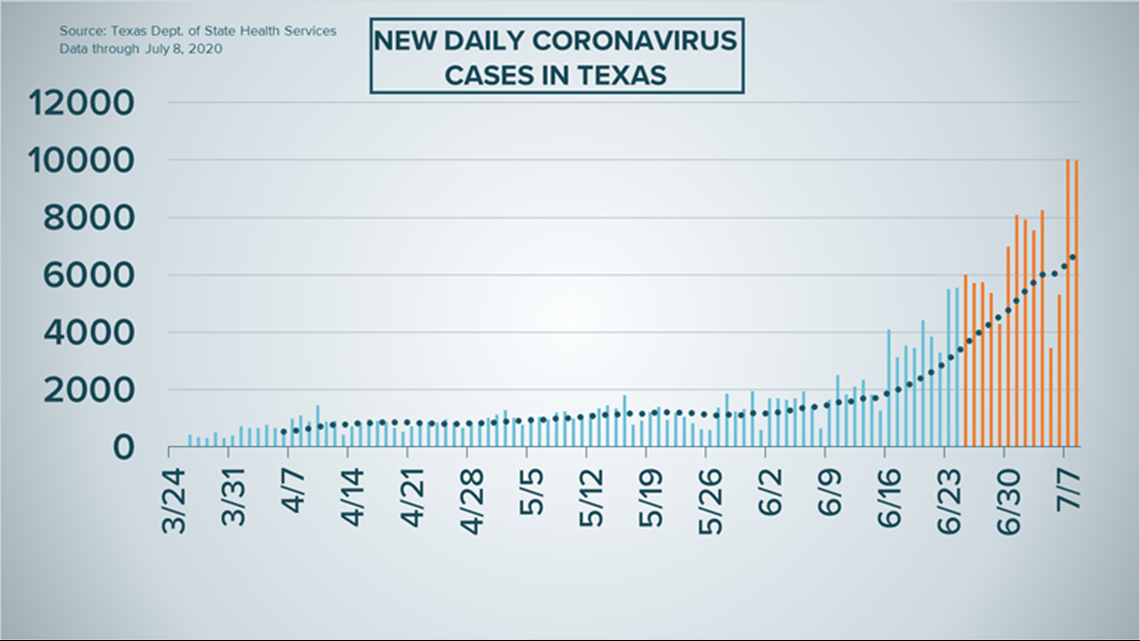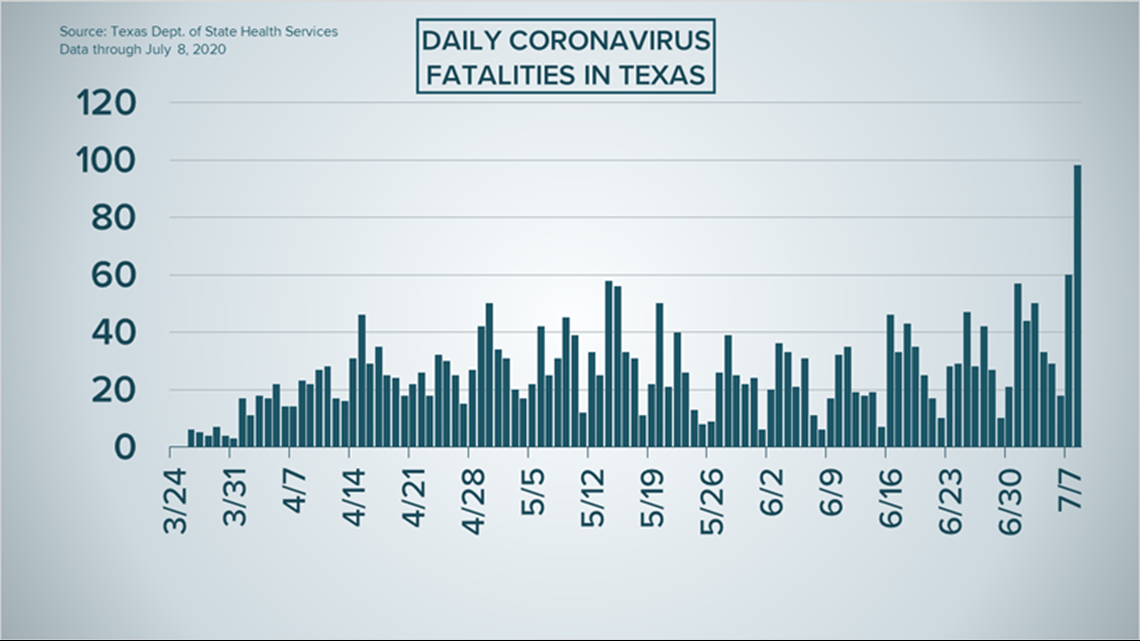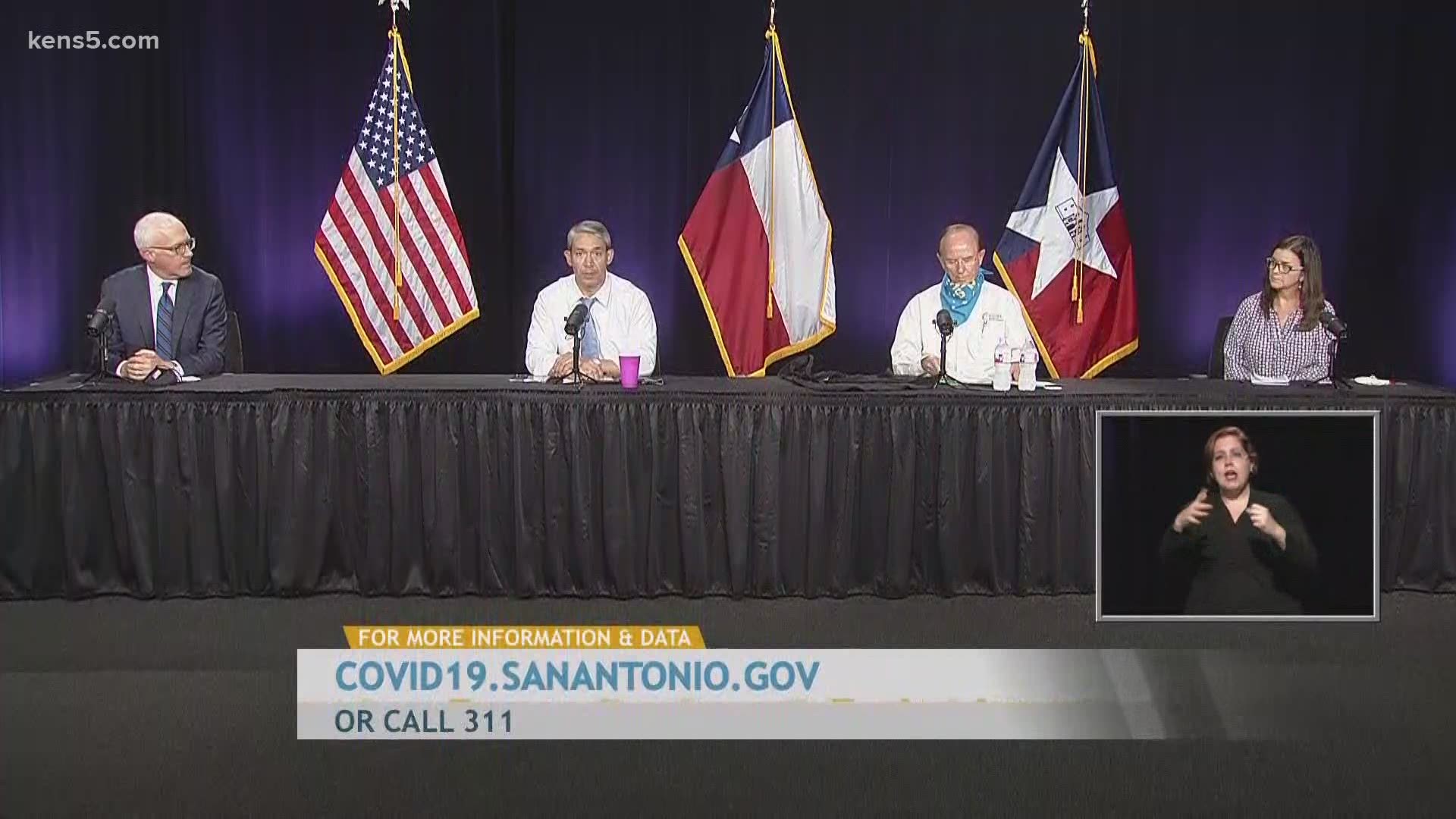SAN ANTONIO — We're tracking the latest numbers from the coronavirus pandemic in San Antonio and across Texas. Here are the latest numbers reported by Bexar and surrounding counties:
- Bexar County: 845 new cases and nine more deaths from COVID-19 were reported Wednesday. There have been a total of 16,725 cases and 146 virus-related fatalities in the county.
- Comal County: Comal County reported 50 new cases of coronavirus Thursday morning (bringing the total to 1,142) and three new COVID-19 related deaths. Eighteen people have now died in the county, while 371 have recovered. The positivity rate 14.06%, up from Wednesday and one week ago.
- Hays County: The county reported 85 new coronavirus cases on Wednesday, along with an additional COVID-19-related fatality. As of July 8, the Hays County Local Health Department confirms a total of 3,328 cases in the county, 2,721 of which remain active. The county's death toll is 11.
Bexar County reports the full numbers daily at 7 p.m.
How Bexar County is trending:
We're tracking how many coronavirus cases are confirmed in Bexar County each day from the time San Antonio Metro Health began reporting cases more than two months ago. Graphing those daily case numbers along a 14-day moving average provides an accurate picture of the curve in the San Antonio area and the direction we're heading amid the coronavirus.
On Wednesday, Mayor Ron Nirenberg reported another grim total of 845 newly confirmed cases of COVID-19 in Bexar County, bringing the total to 16,725. Nine new deaths were also reported, the second-highest number so far; a total of 146 county residents have died from virus-related complications.


However, for the first time in a month, the number of residents currently hospitalized dropped, from 1,235 reported on Tuesday to 1,205.
remains low, however, with just 11% of staffed beds ready to take a patient. And the number of COVID-19-positive patients in ICU (399) and on ventilators (232) continued to rise.


Coronavirus in Texas
Tuesday was the first time state health authorities reported at least 10,000 newly confirmed cases of COVID-19 in the Lone Star State, and Wednesday was nearly the second. Texas confirmed 9,979 new cases of the virus over the last 24 hours, but 98 new virus-related deaths marks a grim new high for this pandemic.
That figure is 30 more than the previous high for deaths reported over a 24-hour period.




Current hospitalizations also reached a new all-time high as the number nears 10,000 for the first time. 324 COVID-19-positive patients were admitted to Texas hospitals over the last day, bringing the total number of hospitalized residents on Wednesday to 9,610.
Latest Coronavirus Headlines
- UTSA says students will have option of going all-virtual in fall semester
- Comal County reports six new deaths tied to nursing homes
- Pregnant with COVID-19: SA woman spent a week in the hospital in fear that her baby would get the virus
- Mala Luna Music Festival canceled due to coronavirus concerns
- United Airlines sending layoff warnings to 36,000 employees, nearly half its work force
- 'Desperation science' slows the hunt for coronavirus drugs
- McConnell eyes coronavirus aid as evictions, benefit cuts loom
- San Antonio bar owner welcomes back patrons on holiday weekend in show of defiance, is promptly shut down by city
- Poll: 81% of Canadians want border with US to stay closed
Coronavirus symptoms
The symptoms of coronavirus can be similar to the flu or a bad cold. Symptoms include fever or chills, cough, shortness of breath or difficulty breathing, fatigue, muscle or body aches, headache, new loss of taste or smell sore throat, congestion or runny nose, nausea or vomiting and diarrhea, according to the Centers for Disease Control.
Most healthy people will have mild symptoms. A study of more than 72,000 patients by the Centers for Disease Control in China showed 80 percent of the cases there were mild.
But infections can cause pneumonia, severe acute respiratory syndrome, kidney failure, and even death, according to the World Health Organization. Older people with underlying health conditions are most at risk.
On June 25, the CDC expanded the list of groups at a higher risk of severe illness due to coronavirus.
Experts determined there was consistent evidence these conditions increase a person's risk, regardless of age:
- Chronic kidney disease
- COPD (chronic obstructive pulmonary disease)
- Obesity (BMI of 30 or higher)
- Immunocompromised state (weakened immune system) from solid organ transplant
- Serious heart conditions, such as heart failure, coronary artery disease, or cardiomyopathies
- Sickle cell disease
- Type 2 diabetes
The CDC believes symptoms may appear anywhere from two to 14 days after being exposed.
Human coronaviruses are usually spread...
- Between people who are in close contact with one another (within about 6 feet).
- Through respiratory droplets produced when an infected person coughs, sneezes or talks. These droplets can land in the mouths or noses of people who are nearby or possibly be inhaled into the lungs.
- Some recent studies have suggested that COVID-19 may be spread by people who are not showing symptoms.
Help stop the spread of coronavirus
- Stay home when you are sick.
- Eat and sleep separately from your family members
- Use different utensils and dishes
- Cover your cough or sneeze with your arm, not your hand.
- If you use a tissue, throw it in the trash.
Lower your risk
- Wash your hands often with soap and water for at least 20 seconds. If soap and water are not available, use an alcohol-based hand sanitizer.
- Avoid touching your eyes, nose, and mouth with unwashed hands.
- Avoid close contact with people who are sick.
- Clean and disinfect frequently touched objects and surfaces.
- The CDC recommends wearing a mask or cloth face covering if you have to be out due to an essential service or essential activity such as going to the grocery store.
- If you are 60 or over and have an underlying health condition such as cardiovascular disease, diabetes or respiratory illnesses like asthma or COPD, the World Health Organization advises you to try to avoid crowds or places where you might interact with people who are sick.

